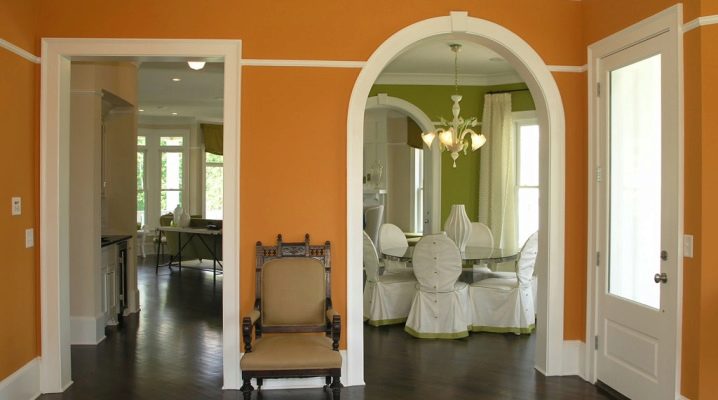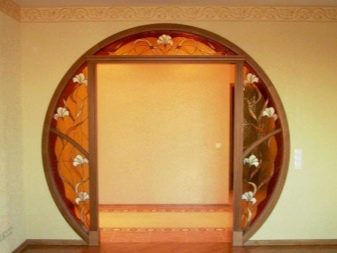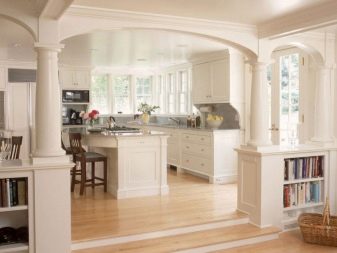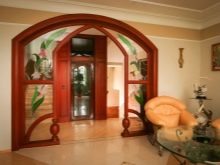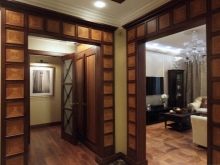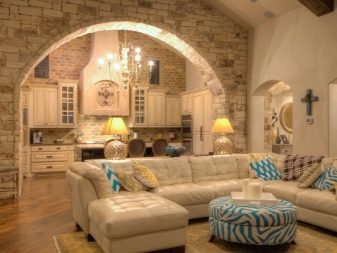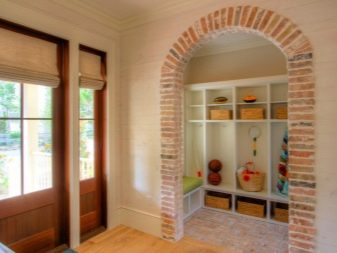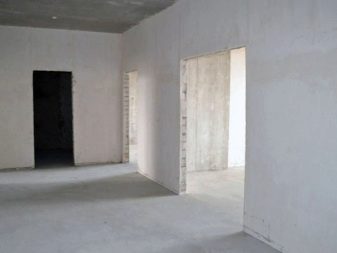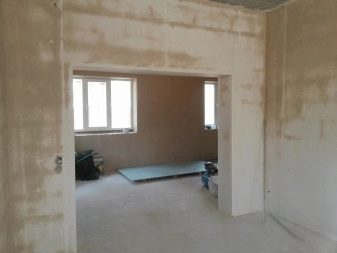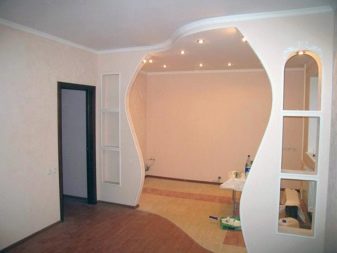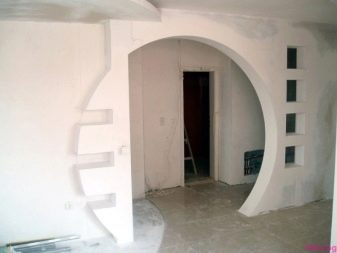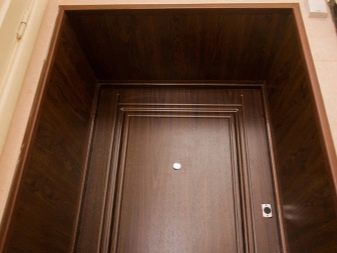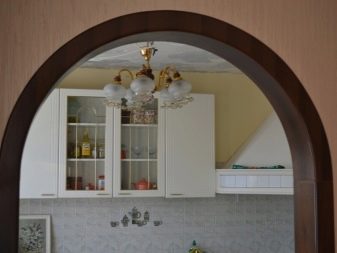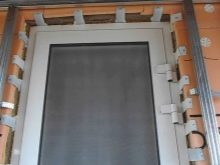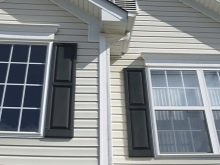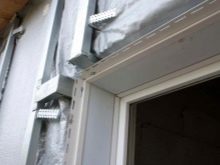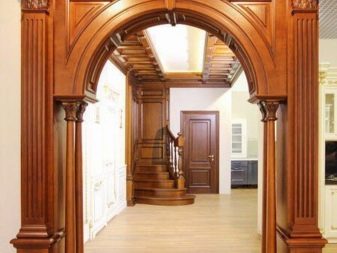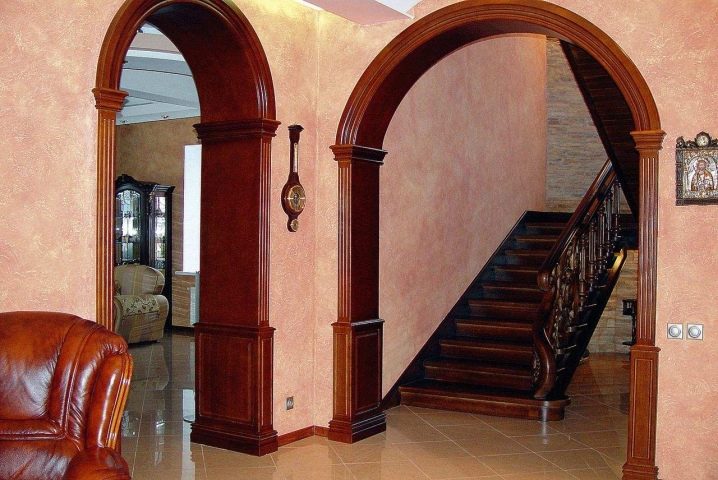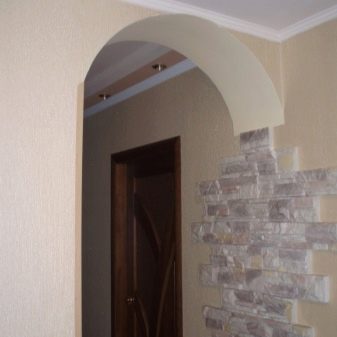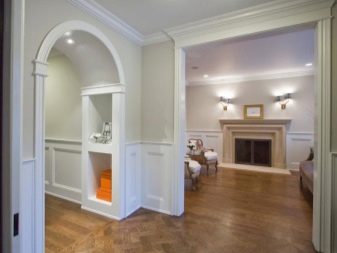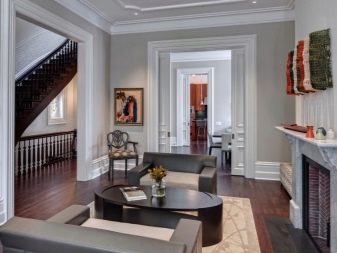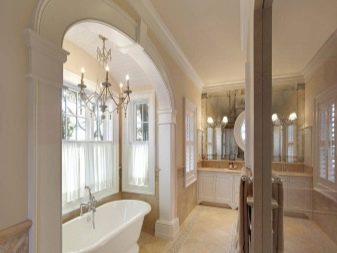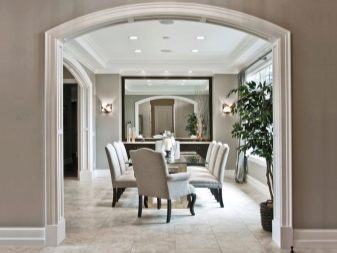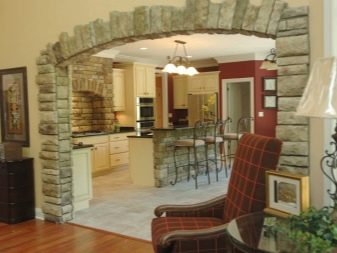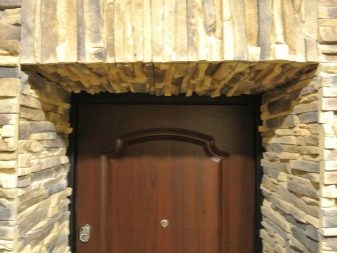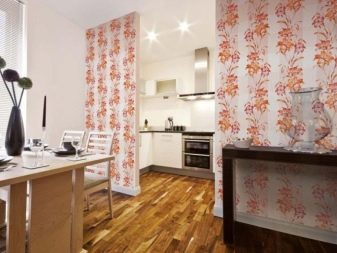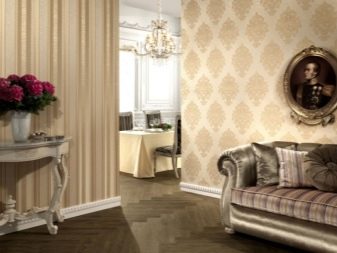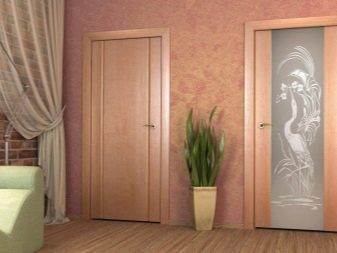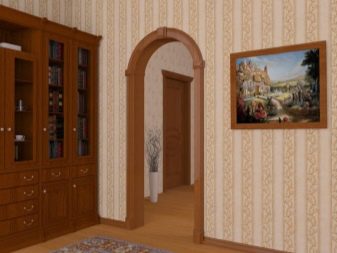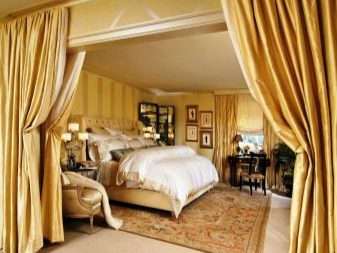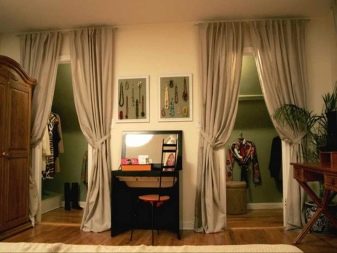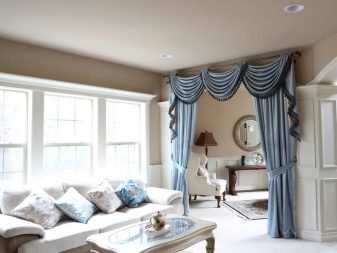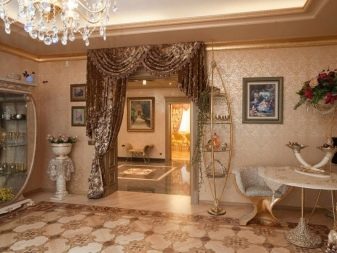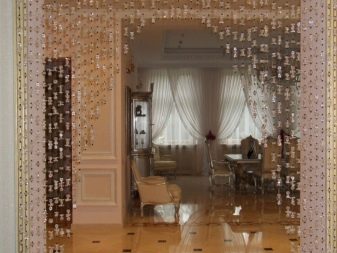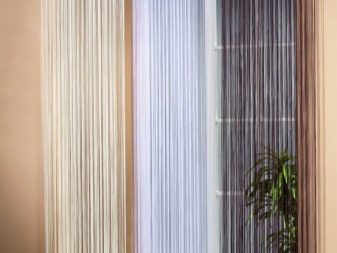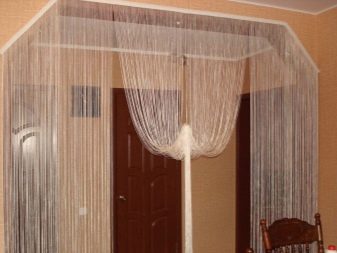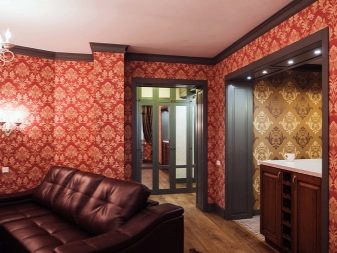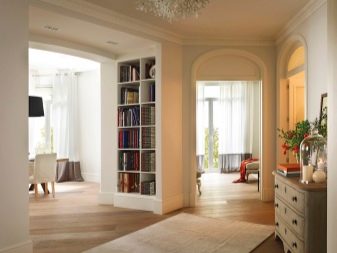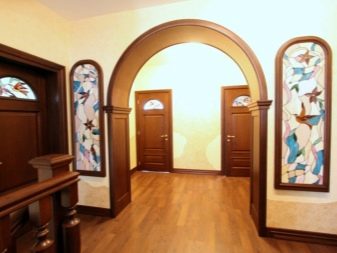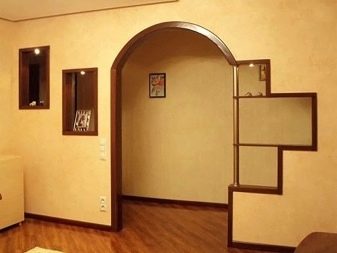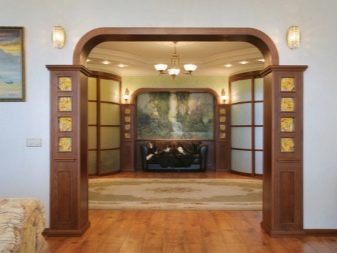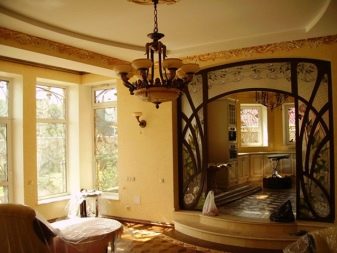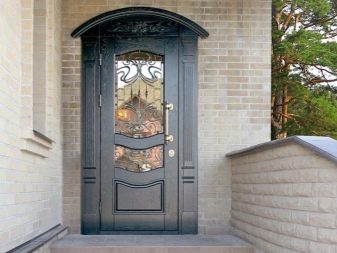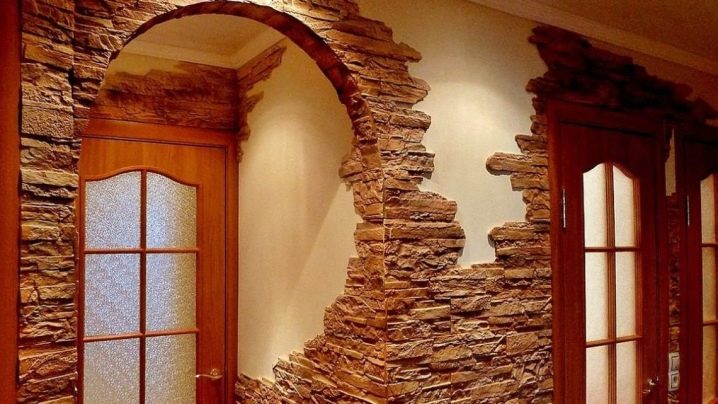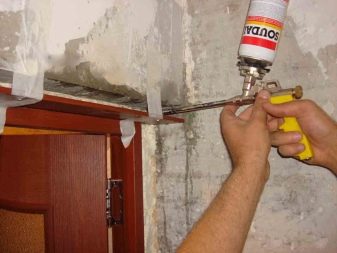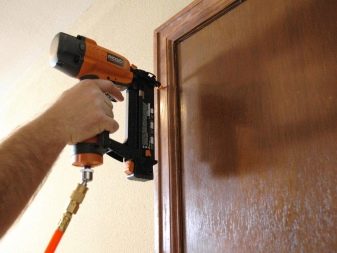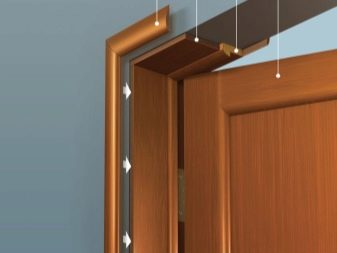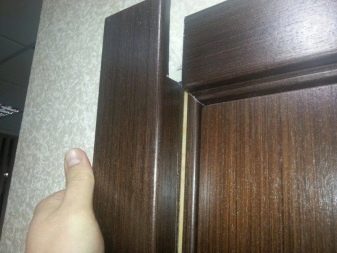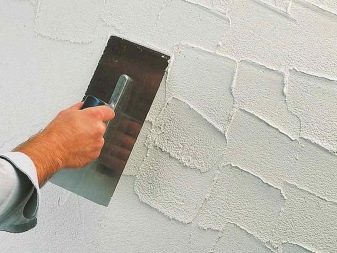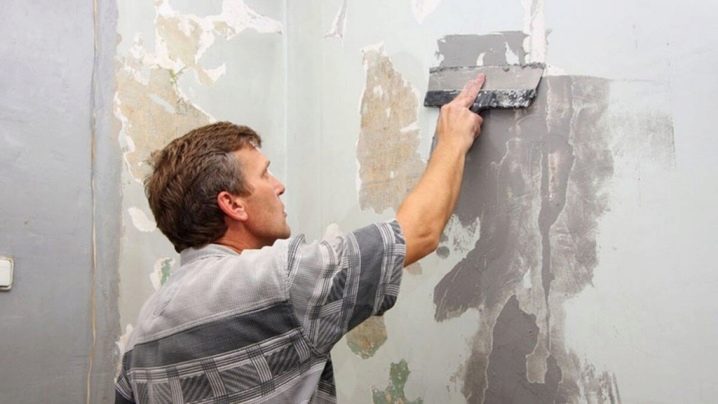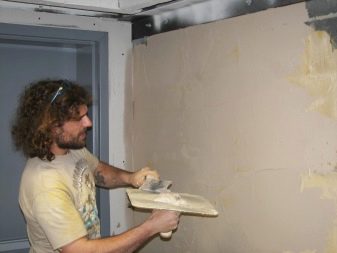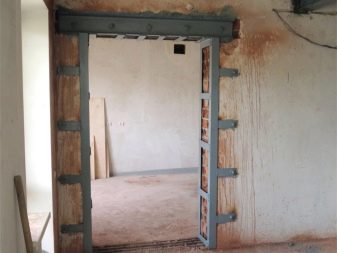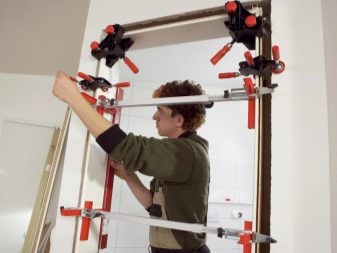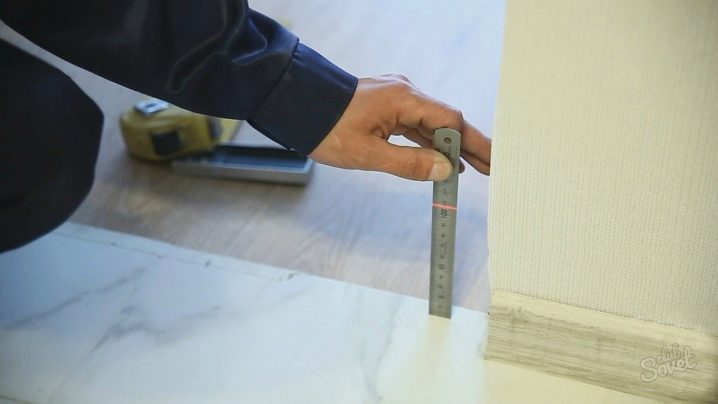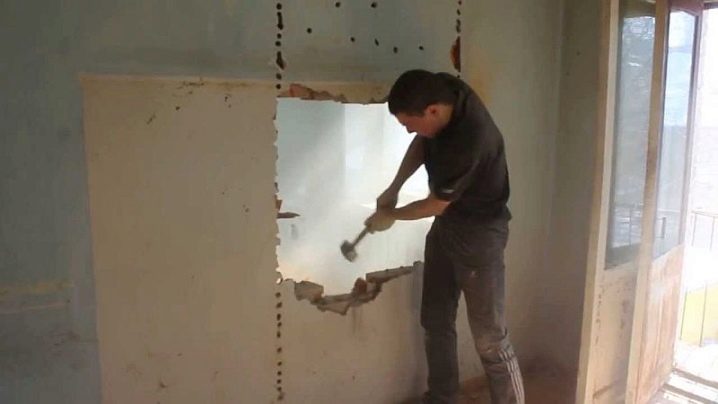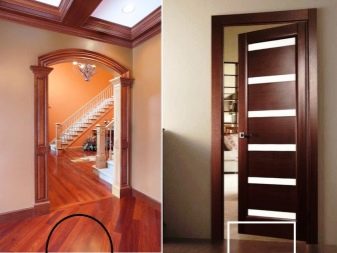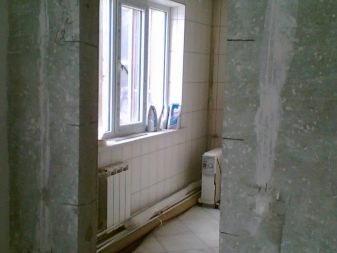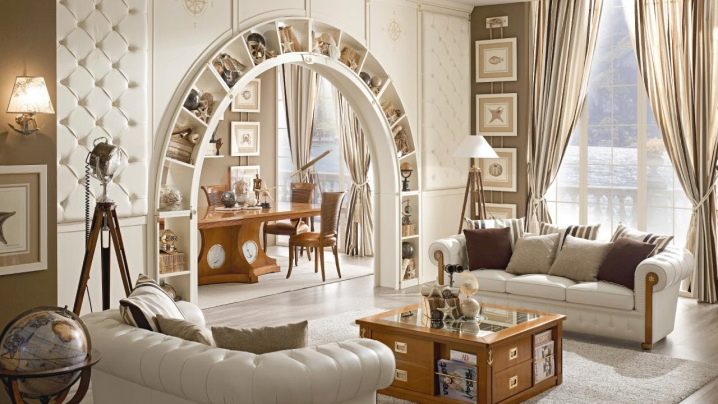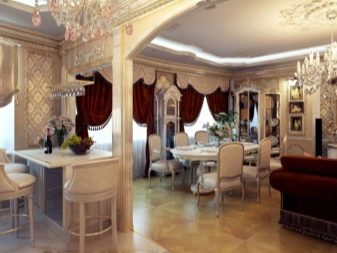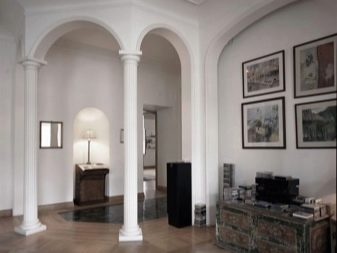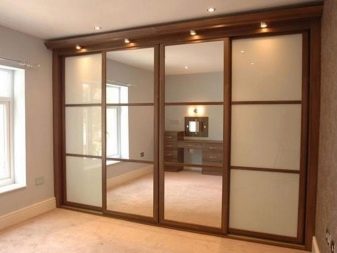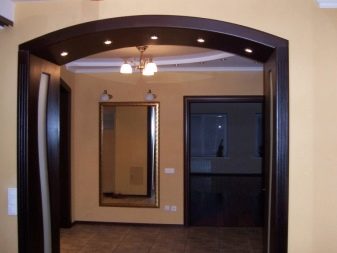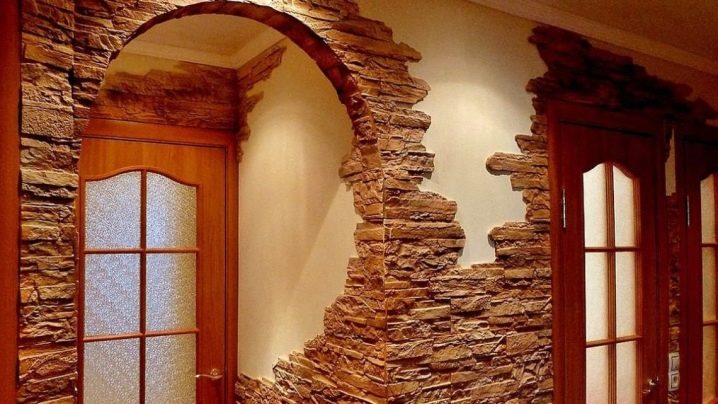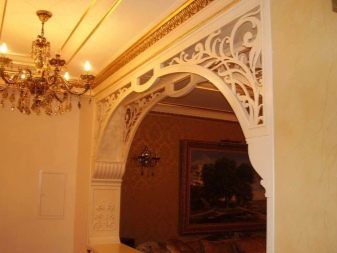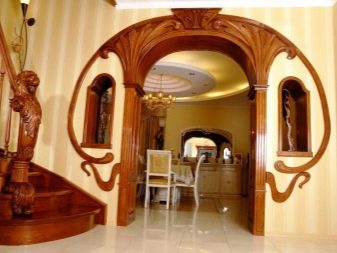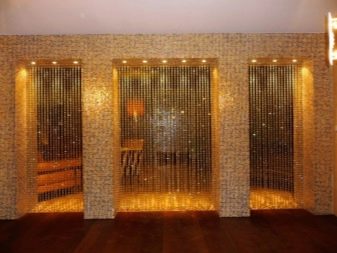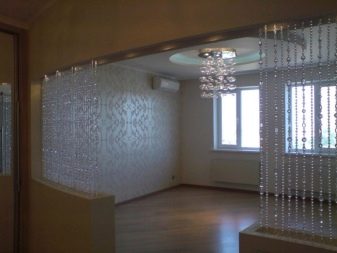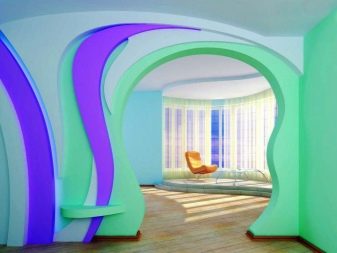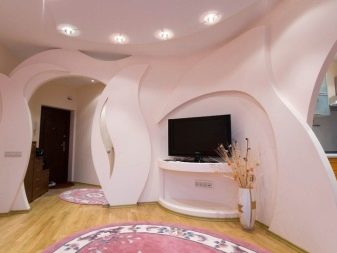How to make a doorway?
Zoning a dwelling using a door is a familiar and necessary thing. A closed door helps to save personal space or protect against noise.
But sometimes a room or corridor is so small that the door interferes, and in other cases the doorway is made so large that the door leaf will be cumbersome and there is no need for it. In houses with thick walls, the door does not look interesting because of the wide empty slopes.
In these cases, the question arises of the aesthetic appeal of such an arch, which means that we need to think about how to arrange the doorway.
Special features
In a typical apartment, very often the walls between the rooms, therefore, the doorways are located below the junction of the ceiling. Such walls are called carriers. They can not be moved or demolished.In this case, the opening must be carefully reinforced with beams.
The situation is simpler in a studio apartment. Bearing are external walls or those that zone the bathroom. On the rest of the space partitions can be put arbitrarily.
In the private house during the construction have already been identified necessary openings. If the house undergoes reconstruction, their location will also depend on the ceiling tiles, beams and load-bearing walls.
- Thus, the first feature of the design of doorways will be adjustment to the supporting structures.
- The second feature is associated with the presence or absence of the door unit in the opening.
- The third is with the desire to visually merge or divide neighboring rooms.
- The fourth feature is a large variety of materials, geometric shapes in the design of doorless space.
- The fifth is associated with the lack of need to care for the door leaf in doorless space.
- Sixth - with savings in cash for the purchase and installation of the door unit.
- At the same time, not all doors can be removed. And this is the seventh feature - the need to preserve the personal space, a closed bathroom with the help of a fixed door.
This means that the doorways can be equipped with a door block or be freely walkable. From this factor depends on the choice of material and lighting during decoration and decorating.
Decor
In order to make an opening, use various options for building and decorative materials. The first will give a new shape, will improve the space, the second will help to decorate it.
- Plaster. That is where the rough work begins when creating a new opening or repair of an existing one. It can be the basis for future lining, or it can itself become a decorative design with the help of textured plaster.
- Drywall is the foundation of future beauty. With it, you can create any shape, hide flaws on the walls and slopes. Sheets of drywall can be bent in unexpected ways.
- Plastic panels - very convenient and practical material of the most different flowers. For their installation do not need specialists. Facing is done quickly and easily. Yes, and they require minimal care.
- Siding. To establish such a cashing is not difficult, and in terms of money it is a very economical option.It is convenient to trim the entrance group with siding, as it is easy to care for it, it is moisture-resistant and does not freeze.
- Wooden panels - no less beautiful, but more expensive. The slats can be horizontally, vertically, diagonally, herringbone. For greater safety and beauty of the tree covered with furniture lacquer. Such a decoration will look beautiful in a wooden house, where the tree itself is an element of decor.
- MDF panels gaining more and more popularity because of its appearance, low cost, ease of installation. Facing such material can be made independently.
- Painting. The most affordable way. The easiest way to work with acrylic water-based paint. Nitro-paint is applied with an airbrush (and this is inconvenient to do in a residential area). Oil paint is used less and less. Enamel will give durability and gloss to an aperture.
- Polyurethane stucco is a large variety of moldings, columns and semi-columns, platbands for framing arches and doors. Light parts and simple installation with glue makes stucco very popular. It comes in white, but is easy to color.
Graceful sandriks, brackets, ornaments in combination with a mosaic will make the doorway a work of art.
- Natural stucco - not cheap stuff. It will be much more difficult to work with it, since it is much heavier than polyurethane.
- Artificial or natural stone. In private houses in the south of Russia, where sandstone, shell rock, limestone practically lies beneath their feet, this is a priority material. But in the construction markets you can buy imitation stones (slate, granite, granite, marble, clinker tiles). The richest choice of decorative stone will help to decorate any walls.
- Wallpapers of various textures and colors - One of the most simple ways to design a doorway. Wall-cover the slopes and adjacent walls can almost everyone.
- Lamination film. The widest variety of colors and types will quickly and inexpensively decorate the opening. But the slopes should be smooth.
- Curtains - A great option for textile clearance opening. An infinitely large selection of fabrics, color range, price range will allow you to perform any design of interior space with a door or without it.
Lambrequins can complement curtains or be self-cashing.
- Macrame or other weaving. It can be executed in any color and quality of a thread. Such a frame can be made of the same length or in the form of a multilevel pattern.
- Kisey or curtains-pendants, curtain - Another option for the design of the opening. And this is a great way to demonstrate your skills, because kiseyu can be made with your own hands. Such a curtain can be bamboo, wooden, plastic, bead, glass beads, beads, seashells, and so on.
How to refine?
There are many ways to improve the interior doorways. The main thing is to choose the right form.
There are several of them:
- rectangular,
- trapezius
- arched,
- pseudoarochnaya,
- asymmetrical.
The easiest way to make a rectangular entrance. If it is made on the site of an old door, then the door block, along with the casing and slopes, must be dismantled. An opening without a door can be finished with any material mentioned above. Okosyachka openings in a wooden house is performed for reliable fixation of logs and plates.
Therefore, additional supports and struts for the corners of the structure can be installed here.which can be interesting to decorate.
For trapezoid entry, any cashing can also be used. After shaping the trapezoid, the opening will have more angles, and, therefore, it will take more time to install slopes made of hard materials. And this is the only serious difference.
Arches are different: classical, elliptical, gothic.
The choice of a particular form depends on the style and purpose of the room, the desired materials for decoration.
- Arch from MDF can be bought in finished form. It will take about 3,000 rubles. Plus about 200 rubles. on assembly foam.
- The arch can be made not from a single sheet of MDF, but from dobor and platbands. This method allows you to draw an opening of any width. In financial terms, this is a very profitable option. In addition, such a frame is easy to use on a brick and concrete wall, since foam is used for installation, and not dowels with screws.
- The arched plasterboard (GCR) is a blank for any further decoration. In this case, you will not have to level the wall in the opening: it will be hidden under the GCR.
- PVC - cladding is recommended to be applied, heated with a building or home hairdryer.This should be done quickly to keep the coverage intact. If you have doubts about your own abilities, then it is better to invite a professional.
- Using soft materials, it is much easier to refine the semicircular arched shapes.
Pseudo-arched construction is a rectangle with rounded plasterboard angles. This arch really looks more like a rectangle than a semicircle.
Gypsum board will help to give an asymmetrical shape to the opening. With it, you can create any design: with inserts, tracery and any other.
Facing the aperture of the iron door
Entrance doorways require special decoration. They must be warm, non-marking, resistant to abrasion, safe. This is especially true of the metal door, as the coldest.
MDF perfectly cope with this task. Finishing of this material will help to establish cashing on your own. Telescopic cashing is considered the easiest way due to the ease of installation. It is made on the lining principle: on the one hand it is provided with a groove, and on the other - with a comb. By inserting a comb into the groove, you can make a shield of any width.
Another design option - upholstery, for example, leatherette. Beforehand, it is necessary to calculate well whether it will not interfere with the movement of the door itself. In addition, when creating a thick layer can significantly reduce the opening. Therefore, in narrow rooms to use this option is impractical.
But cashing in with an artificial brick or stone will make the opening beautiful and will not steal space. It is easy to stick it with your own hands.
Veneering is ideal for facing the entrance group, as the veneer is strong and durable.
Types of mounts
Depending on the material chosen, the types of attachment will be different. In modern construction, foam is used not only as a sealant, but also as a fastener. Therefore, MDF panels, for example, are put on foam. After complete drying, the remains are cut with a sharp knife.
Specialists use finishing nails for cashing in wooden openings. Their convenience lies in the fact that, after driving in, the caps are practically invisible on the material. For brick and concrete walls it is convenient to use liquid nails. This adhesive substance is applied on the reverse side of the solid material, after which it is fixed on the slope and pressed tightly against the wall.
You need to do it carefully, as the liquid nails seize very quickly, and the strips and panels are dismantled difficult.
Panels can be mounted on screws. In the wooden openings you first need to make small holes with a drill, and only then screw in the screw. Otherwise, the tree may crack. In the brick and concrete walls will have to drive dowels (pre-drilled holes for them), and already in them screw screws.
The easiest fastening method is a “beak” type latch. It is on this principle that telescopic platbands are attached. The downside of this method is the separation of the casing itself with frequent dismantling. But the door is installed only once. And if the time has come to dismantle it, it means that it is not needed, just like the old trim.
Therefore, do not fear the premature loss of the appearance of the cashing.
How to level the surface for work?
Having decided on the material and form, you need to prepare the slope for the design. If for the further decoration of various types of panels is not so important, then under the wallpaper, painting, laminate surface should be perfect. Alignment can be done with plaster or drywall.
Plaster
You need to start with the removal of the layer of old plaster. The better this work is done, the fewer then there will be problems with the slope. Next, you need to seal the potholes and cracks with cement mortar. Small gaps are rubbed with putty, and the distance between the door frame and the wall is filled with mounting foam.
In the process of preparation, it is necessary to remove the hillocks of old cement and hardened excess foam from the wall. After that, the surface is treated with a primer, which will increase the adhesion of the plaster and the wall.
Plaster slopes can be a cement mortar (cement, water, sand) or plaster (cement, sand, lime solution). The shops sell ready-made mortar plaster, as well as cement composition, which you only need to add water.
There are several ways of applying the solution on the wall, but with any of them in order to make the surface smooth, you need to install vertical beacons. It can be slats that attach alabaster to the slope. After the beacons have dried, a solution is applied to the wall and leveled with a spatula. To plaster in such a way conveniently vertical slopes, with the ceiling it is more difficult to do.After complete drying of the plaster it is decorated in any way.
Drywall
This material can improve the openings of any configuration. And this is the advantage of GCR. Perhaps no other material can cope with the asymmetric form.
After selecting the shape of the structure, you need to create a scaled pattern on paper. On it on a sheet of paper cardboard or other hard paper make a template of natural size, which is transferred to the wall drywall. The number of copies depends on whether the form is symmetrical.
Next, in the doorway set the metal profile. To give the profile an arched shape, it needs to be trimmed with special scissors for metal every ten centimeters. The metal profile is attached to the opening. To create the arch of the arch, you will need a ceiling GCR - it is thinner and can be bent according to a pattern.
This is done with a special needle roller. Plasterboard billet plentifully moistened with water and rolled with a roller. The billet is softened, it is given the desired shape and left to dry for ten hours.
After drying, all elements of the arch are fastened with self-tapping screws to the frame of metal profiles.Next, using the serpyanki tape, close up the joints of the sheets, and the grooves from the screws are rubbed with plaster filler. When this layer dries, putty the entire structure, and then sand it with sandpaper. At this preparatory stage of work is completed, then the design is waiting for the finishing.
When creating an asymmetric multi-component design, there may be more details. And not every home master will cope with such work. To get a high-quality and reliable design, it is better to entrust the work to professionals.
Dimensions
The most reliable measurement of the doorway in which the door will be installed is to be entrusted to a specialist. But due to circumstances or one's own desire, sometimes it is necessary to measure this space on one’s own.
How to do it right:
- Measure the width, i.e. the distance between the walls. At the same time, at the entrance aperture the width at the door will be less than on the inside of the wall. In addition, due to a construction defect, the distance at different points may also differ. It is important to find the bottleneck.
- Measure the height, i.e. the distance from the threshold to the lowest point of the opening above the head.
- Measure the depth, that is, the thickness of the wall.This should be done at the bottom, in the middle and at the top of the opening.
GOST defines the typical dimensions of doors and openings. You can see them in the table below. This is done to simplify calculations when designing apartments. In private homes are not always used these sizes. But in this case, the project of the door unit will be individual, which will significantly increase its value.
Measurements of the opening without a door are important in order to correctly calculate the need for materials. Very often, an error of 5 or even 10 cm is not fundamental. However, the more thoroughly the measurements are made, the fewer surprises there will be during installation.
How to transfer?
Moving the doorway - perhaps the most difficult question. Especially if it concerns an apartment in an apartment building.
To avoid fatal errors, consider the following:
- what material the wall is made of;
- what is the layout of housing;
- is this wall bearing;
- how do the dimensions of the opening relate to the bearing wall;
- what is the state of overlap;
- what is the thickness and condition of the walls.
Having decided on the project, you need to perform a technical expertise, then coordinate it in various committees.This is followed by the receipt of technical specifications, design permission and approval of the project itself. To solve all these issues, there are special organizations, or the owner solves them independently.
Possible options for the transfer of the opening:
- The doorway, having the standard sizes, in the bearing wall. It can be pierced from scratch. Since there is a redistribution of the load on the floors and walls, it is important to decide the question: will the previous passage remain or will it be laid.
- More time-consuming option - the arch. If it is sawn in a concrete wall, then a more sophisticated technology is used in the brick wall, which only a professional can handle.
- A slight shift or widening of the opening in the same place is the safest option. The jumper increases or shifts. Unnecessary part of the passage should be sheathed with drywall or lay a brick. On the other hand, they cut out part of the wall of the required dimensions.
Successful examples and options
The value of this arch in its functionality. This is not only an example of beautiful design, but also a combination with shelves that are never superfluous.
This design option is possible in large rooms with high ceilings.A wonderful example of zoning space using natural stucco.
The use of modern materials will keep such an opening for a long time, and the built-in illumination will help with this.
The design of the entrance group and corridor passage in the same style is the perfect solution for the hallway. Decorative stone will help preserve the appearance.
This arch of wood can be done by yourself. It perfectly zoning and highlights the space.
Thanks to the built-in illumination, this glassy bugle made the passage unusually beautiful.
Despite the unusual colors, this asymmetric arch looks great and hides non-standard room dimensions.
The following video is about how to make a doorway with your own hands.
